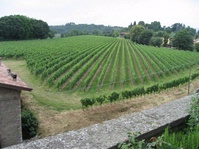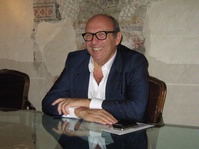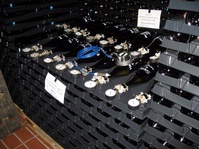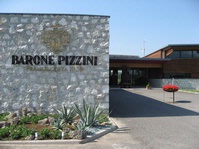Most wine geeks are not familiar with Franciacorta, so it’s understandable that this terrific Italian bubbly is not on the radar screens of most casual consumers.
When I told a friend I was going to Italy to learn about their sparkling wines, his response was, “Oh, I love Prosecco.” He, like most Americans, was unaware of any other Italian bubbly. Christina Ziliani, currently the head of the communications for the Guido Berlucchi winery, cringes when she hears the all-too-familiar refrain from importers that, “We don’t need a new category. We already have Prosecco.”
Well, Franciacorta is most definitely not Prosecco, not even a fancy Prosecco. The producers shudder when people start to make the comparison. Their reaction is understandable, since this sparkling wine 
It pays to learn about Franciacorta, located on the southern shore of Lake Iseo about 40 miles east of Milan, because the overall quality is excellent and prices should make you want to try a bottle or two. The wines have considerable refinement, and many cost less than $25 a bottle. As a category, the wines over-deliver for the price. In short, Franciacorta is Italy’s leading sparkling wine area and, in terms of quality, is to Italy what Champagne is to France.
Same Grapes and Method as in Champagne
In Franciacorta, winemakers use the same major grapes, Chardonnay and Pinot Noir (Pinot Nero) that winemakers use in Champagne. “Pinot Noir gives perfume and complexity,” according to Enzio Majolini, the head of Majolini, one of the region’s top producers. It also adds weight to the wine. When incorporating a third grape in the blend, producers use Pinot Bianco (a.k.a. Pinot Blanc) instead of Champagne’s Pinot Meunier. Unlike Pinot Meunier, which is seen as a “lesser” grape in Champagne, Pinot Bianco stands on equal footing with the other two varieties in Franciacorta, judging by the roughly equal prices each of the varietals command when producers purchase them from growers. Pinot Bianco adds captivating white flower aromatics, and there are some top producers, such as La Boscaiola, who treasure that variety and have resisted any urge to uproot it in favor of Chardonnay.
The Franciacorta winemakers use the same method as in Champagne, a secondary fermentation in the bottle and prolonged contact with the yeast (lees) to transform still wine into a gloriously complex bubbly. Indeed, the strict regulations for Franciacorta require that the wine age in contact with the lees for more time than is required in Champagne.
Quality is the Focus
Maurizio Zanella runs Ca’ del Bosco, one of the area’s top tier producers, and is the president of the Franciacorta Consorzio–the body that governs 
The producers I met were clearly passionate and intent on increasing the quality of this already outstanding DOCG (Denominazione di Origine Controllata e Garantita, Italy’s highest category of appellations for wine). Silvano Brescianini, the General Director of Barone Pizzini, a stellar producer whose production is entirely organic, is adamant that organic farming is the way of the future. Enzo Majolini typifies the growers’ enthusiasm for the potential of the area when responding to the question, which is your favorite wine? “My favorite is always what we will produce next year.”
It’s the Climate
Although similar to Champagne in winemaking technique and blend, the climate in Franciacorta is vastly different, and this in turn explains the difference in style between these two upscale bubblies. Franciacorta’s climate is notably warmer than that of Champagne because it is located considerably further south, which gives the wines a softer and more lush profile than their French counterparts. Tasting the still wines from the two areas before they undergo a secondary fermentation etches on the palate the importance of climate. The base (still) wine in Champagne is practically undrinkable due to its leanness and enamel-removing acidity, whereas the base wine in Franciacorta is rounder and easier to taste. Indeed, the ripeness and balance of the base wines in Franciacorta makes me wonder whether producers should try their hand at still table wines from Chardonnay, Pinot Noir and Pinot Bianco.
With a mixture of limestone and glacier sediment, the soil in Franciacorta bears similarities to Burgundy, another top-notch area for Pinot Noir and Chardonnay. This too helps explain the complexity of the wines.
Four Basic Styles
There are four basic styles of Franciacorta: Satèn, Brut, Rosé, and Non Dosage (a.k.a. Extra Brut, Pas Dosé, Sans Dosage or Zero Dosage), all of which can be non-vintage or sourced from a single year (vintage dated). 
Satèn
Analogous to Champagne’s Blanc de Blancs, Franciacorta produces Satèn, a bubbly made entirely from white grapes–Chardonnay and Pinot Bianco–and with slightly less fizz so it has a creamier, softer (satiny) texture. Lucia Barzanó, who, along with her brother Julio, runs the fine Il Mosnel estate, says that Satèn is a very important category: “It is an easier wine to drink and the perfect way to start to explore Franciacorta.” The combination of the inherently riper character of Franciacorta coupled with less carbonation certainly makes the Satèn a marvelous aperitif. Pierot Bonomi, the winemaker at Antica Fratta, another top house that makes bold, yet still elegant, wines describes Satèn as “A true expression of Chardonnay in the Franciacorta zone.”
Brut
Brut is the most widely available style of Franciacorta. Regulations allow any blend of the three varietals. Typically the dosage is less for Franciacorta Brut than for Brut Champagne because the wine itself delivers riper flavors. Lovely as a stand-alone aperitif because of its softer profile compared to Champagne, Brut Franciacorta has enough backbone to stand up to food, such as a creamy risotto or prosciutto.
Rosé
Though producers use a variety of techniques for Franciacorta Rosé, a 
Non-Dosage
For me, the Non-Dosage category holds the most interest because these wines have the most structure. Unlike Zero or Non-Dosage Champagne, which can be austere since the wine’s acidity is more apparent without the addition of sugar to soften it, the inherently riper, less acidic grapes in Franciacorta make a more friendly Non-Dosage bubbly that needs no added sugar. Arturo Ziliani emphasizes that producers must use only the top wines for a non-dosage because you can’t “fix the wine” by adjusting the dosage. The Non-Dosage category is especially welcome to those who might avoid Franciacorta in general since they are softer than Champagne.
Worth the Search
Franciacorta is a small DOCG–roughly 7,000 acres or about one-tenth the size of Champagne–that currently produces only about 14 million bottles annually. To put that figure into perspective, Veuve Clicquot Ponsardin alone produces more than the entire Franciacorta zone. The wine has become “hot” in Italy (a decade ago production was a mere 4 million bottles), and the area has become very trendy, causing land prices there to skyrocket. Italians still gobble up 90 percent of the production, so finding Franciacorta on these shores may require the expenditure of some energy. Nevertheless, these wines are well worth the effort.
October 15, 2013
